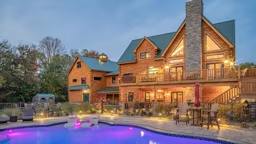
Photo: Expedition Log Homes
If there’s one person who can make or break the log home experience for you, it’s your builder. No matter how expertly your log home company has prepared each element of your package, without a qualified person and his team to assemble those pieces, you could be headed for a headache (or worse, a heartache) if your home isn’t properly constructed according to the producer’s instructions. For a smooth hiring process, commit to our five easy steps to building success. Soon you’ll be on your way to building this essential relationship — and, of course, the log home you’re longing for.
1. Gather a list of names.
Make it easy on yourself and start your builder search with your log provider. Although some companies won’t recommend a specific builder (unless they’re producing a turnkey home for you), they should be able to offer names of builders who have worked with their building system before — and, in some cases, have the inside track on a builder’s reputation and level of experience.
Also, you can (and should) take matters into your own hands by gathering some additional prospects. Call your local home builders’ association and ask for members who list log homes as a specialty.
2. Set up your interviews.
Meeting face to face will give you a good read on the builder’s knowledge, philosophy and personality. Ask how many log homes each person has built — and for which manufacturers. Every company has a different building system, so a direct connection to your chosen log provider is preferable. That said, a high-end custom home builder who may not have a lot of log homes under his tool belt still may be someone to consider. These folks are used to reading complex plans and solving site challenges on the spot. This is also the time when you’ll want to see a builder’s license and obtain a copy of his certificate of insurance.
3. Inspect each builder’s work personally.
Don’t rely on photos to judge a builder’s craftsmanship. Visit at least two homes per builder. If he or she won’t refer you to homes you can visit, that should raise a red flag. If possible, look at homes that were built at least three to five years ago to give you a sense of how his or her work holds up over time. Inspect the home’s durability and workmanship. Some things to look for: Has the caulking/chinking held up? Are floors settling evenly? Do doors and windows open easily and close snugly?4. Make connections with each builder’s subcontractors.
Builders work with a variety of specialized subs, like electricians, plumbers and stonemasons, who can offer a great deal of insight as to how it will be working with the builder. During the interviews, ask if the builder you’re considering can be reached easily, especially if problems occur, and if he’s reliable and pays his bills on time. Find out what each contractor feels is the best — and the most challenging — part of working with your prospective builder.5. Draft a short list and solicit itemized bids.
As the bids arrive, be sure you’re making true comparisons. For instance, is each builder offering the same level of construction supervision? Is each one’s building time line comparable? Don’t base your decision on price alone or you could end up with a hands-off contractor.Once you’ve identified your top choice, request a written contract that includes the itemized details of the project. As you move forward, maintain a business relationship with your builder during each step of the negotiation process and construction. In some cases, contractors may get too close with their customers and unintentionally influence key construction decisions. Remember: This is YOUR home, but do rely on your builder’s years of experience to guide you.
P.S.! A Note on Crew Size
How many people can you expect on your job site? For a 3,000-square-foot house, a good balance is five to seven skilled workers with one extra laborer.











